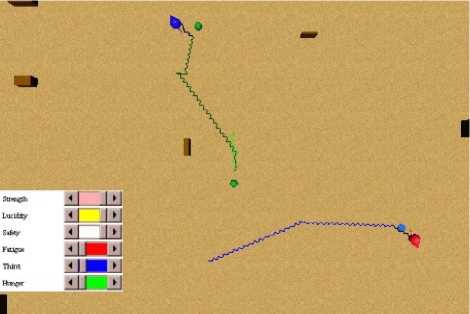6.1.6. Non persistence of a consummatory action in the presence of an aversive stimulus
In this experiment we will test the non persistence of a consummatory action (eat) of a
prey animat in the presence of a predator. We have an initial state as the one shown in Figure
39: a hungry prey animat, perceiving a food source, but not perceiving a thirsty predator that
is nearby. The prey animat perceives the predator while he is eating, and runs away before he
satiates his hunger completely, as seen in Figure 40.

Figure 39. Initial state of the experiment. Figure 40. The prey animat runs away before
satiating his hunger.
Afterwards, the prey animat perceived another food source, which he was able to satiate
his thirst with, as seen in Figure 41. We used a value of 6 equal to 0.9. Otherwise, the
persistence would have been enough to satiate the hunger of the prey animat. If the prey
animat would eat slower, with a usual value of 6 we would have obtained similar results.

Figure 41. The prey animat was able to satiate his
hunger with another food source.
79
More intriguing information
1. Apprenticeships in the UK: from the industrial-relation via market-led and social inclusion models2. The Economic Value of Basin Protection to Improve the Quality and Reliability of Potable Water Supply: Some Evidence from Ecuador
3. Endogenous Heterogeneity in Strategic Models: Symmetry-breaking via Strategic Substitutes and Nonconcavities
4. Life is an Adventure! An agent-based reconciliation of narrative and scientific worldviews
5. The name is absent
6. LIMITS OF PUBLIC POLICY EDUCATION
7. The name is absent
8. The Complexity Era in Economics
9. Monetary Policy News and Exchange Rate Responses: Do Only Surprises Matter?
10. The name is absent